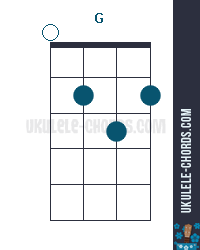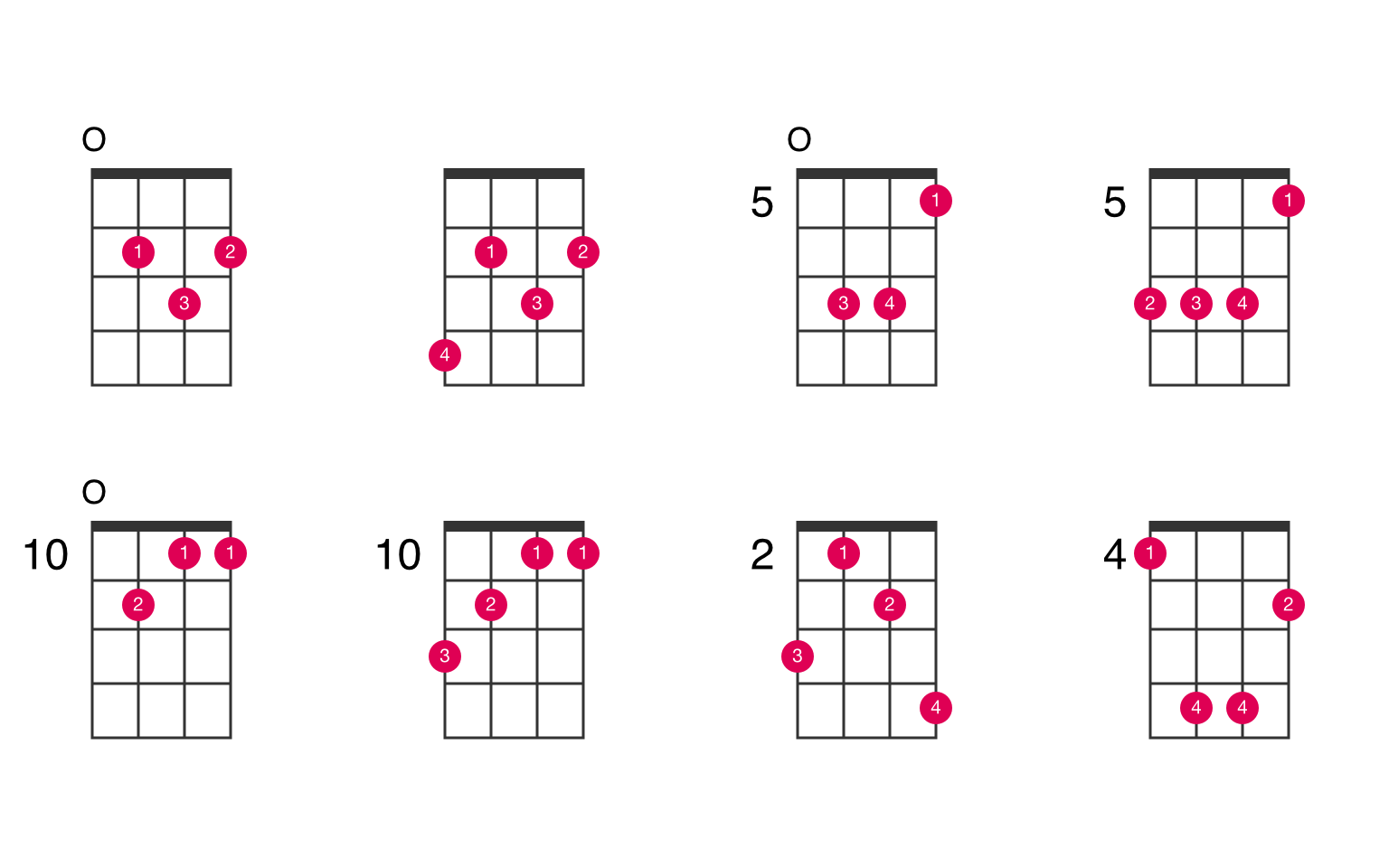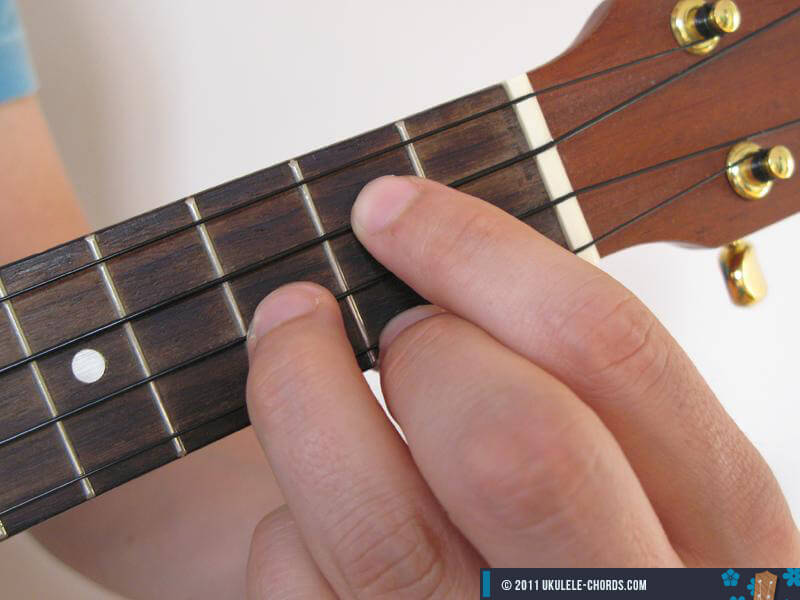The G chord on the ukulele is played by positioning your fingers on the 2nd, 3rd, and 4th strings. It requires pressing the 2nd fret of the 1st and 3rd strings, and the 3rd fret of the 2nd string.
Mastering chords is essential for any ukulele player, and the G chord is one of the fundamental chords used across countless songs. It’s a major chord with a bright, cheerful sound, adding richness to a variety of music genres. To play the G chord smoothly, start by placing your index finger on the 2nd fret of the C string (third string), your middle finger on the 2nd fret of the A string (first string), and your ring finger on the 3rd fret of the E string (second string).
Ensure each finger presses down firmly to avoid muted notes. With regular practice, transitioning to and from the G chord becomes second nature, allowing for fluid play and progression in your ukulele skills.
Grasping The G Chord
Strumming the ukulele brings joy to both the player and listeners. A key chord to master is the G chord. It opens a door to countless songs.
The Basics: Ukulele Tuning
Proper tuning is crucial before learning new chords. Four strings on the ukulele typically tune to G, C, E, A. This is known as standard tuning.
Finger Placement For G Chord
Correct finger placement is essential to play the G chord clearly. Here’s a step-by-step guide:
- Position your index finger on the third string at the second fret.
- Place your ring finger on the first string at the third fret.
- Your middle finger goes on the second string at the second fret.
This formation should resemble a triangle. Your fingers will not be on the same fret. They will achieve the distinct tone of the G chord.
| String | Fret | Finger |
|---|---|---|
| 1st (A) | 3rd | Ring |
| 2nd (E) | 2nd | Middle |
| 3rd (C) | 2nd | Index |
| 4th (G) | Open | None |
- Check each string to ensure it rings clear.
- Practice the transition from and to other chords.
- Repeat the process until it feels natural.

Credit: ukulele-chords.com
Origins Of The G Chord
The G chord is a staple in ukulele music. This chord, consisting of three main notes, has origins tracing back through centuries of string instrument history.
History In String Instruments
String instruments like the lute and the violin have utilized the G chord for ages. In these early instruments, the chord’s structure was anchored in traditional music theory.
- The lute, popular in the Renaissance, had the G chord in many songs.
- Violins, central to orchestral music, often feature the G chord.
- Guitars, cousins to the ukulele, share similar chord shapes, including G.
The G chord’s formation involves a perfect fourth, a major third, and a minor third. It is fundamental in creating harmonious music.
Popularity In Ukulele Music
In ukulele music, the G chord gained popularity for its pleasant sound and versatility. It is one of the first chords learners master.
| Finger Position | String | Fret |
|---|---|---|
| Index Finger | C String | Second Fret |
| Ring Finger | E String | Third Fret |
| Middle Finger | A String | Second Fret |
Ukulele artists often use the G chord in a variety of genres, from pop to traditional. Its bright tone complements the ukulele’s cheerful sound.
- Popular songs frequently include the G chord for a catchy tune.
- Beginners find it easy to transition into other chords from G.
- Many ukulele tutorials start with the G chord due to its essential nature.
Playing The G Chord
Mastering the G chord is essential for ukulele enthusiasts. It’s a versatile and common chord that adds richness to songs. To play the G chord, you need to place your fingers in the right positions. Let’s break down this fundamental chord step by step.
Strumming Techniques
Understanding strumming patterns boosts your G chord sound:
- Down-Up Strum: Move your hand down and up for a simple rhythm.
- Island Strum: Create a tropical vibe with a down, down-up, up, down-up pattern.
- Thumb Strum: Gently glide your thumb for a mellow tone.
Transitioning Between Chords
Effortlessly shift to and from the G chord. Practice makes perfect:
- Start with the G chord. Strum slowly.
- Move to the C chord. Keep your rhythm steady.
- Return to the G chord. Speed will come with time.
Repeat these steps to build muscle memory. Soon, your transitions will be smooth and second nature.

Credit: ukelib.com
Common Challenges
Mastering the G chord on the ukulele can be a hurdle for beginners. This common roadblock often stems from two main challenges: finger positioning and sound clarity. Tackling these difficulties head-on is key to fluency and confidence while strumming your favorite tunes.
Overcoming Finger Position Difficulties
The G chord requires precise finger placement that can seem demanding for novices. New players might feel their fingers cramped or stretched uncomfortably.
- Start slow. Speed comes with practice.
- Use a mirror. It ensures correct finger positions.
- Consistent practice. It builds muscle memory for ease in positioning.
Visual chord diagrams show where each finger goes. Follow these diagrams closely to get accustomed to the correct formation.
Maintaining Clean Sound
Muffled or buzzy notes often happen if your fingers lightly brush against the strings. It’s common and fixable with a few adjustments.
- Ensure your fingers are not touching adjacent strings. This avoids unwanted muting.
- Use the very tips of your fingers to press down on the strings. This technique aids in a clearer sound.
- Regularly check your tuning. An out-of-tune ukulele can sound off, even with proper fingering.
Remember, producing a clean and vibrant sound is a testament to your mastery over the G chord.
Practice Makes Perfect
Mastering the G chord on the ukulele is essential for any budding musician. It opens the door to countless songs and melodies. But it takes dedication to perfect. Like any skill, consistent practice is key. The journey might seem challenging, but with the right techniques, the G chord will soon feel like second nature. Let’s explore some effective ways to practice and exercises that will help you master this fundamental chord.
Effective Practice Tips
Focused, efficient practice sessions lead to significant improvements. Here’s how to practice the G chord effectively:
- Set clear goals: Aim for small, achievable milestones.
- Daily practice: Even just 10 minutes a day can make a big difference.
- Slow, deliberate movements: Build muscle memory without haste.
- Use a metronome: Maintain a steady rhythm as you practice.
- Seek feedback: Record yourself or play for others to get advice.
Exercises For Mastering The G Chord
To cement the G chord into your skillset, try these exercises:
- Chord transitions: Switch between G and C chords, gradually increasing speed.
- Strumming patterns: Practice different patterns while holding the G chord.
- Finger placement drills: Repeat placing your fingers on the fretboard until it feels natural.
- Chord variations: Explore different voicings of the G chord to expand your versatility.
Remember, patience and consistency are crucial. Over time, these exercises will make the G chord a favorite in your ukulele arsenal.

Credit: ukulele-chords.com
What Are the Differences Between the G Chord and the D Chord on the Ukulele?
The G chord and the D chord on the ukulele differ in their finger placements and sound characteristics. The G chord creates a bright, cheerful tone, while the D chord has a more resonant, uplifting quality. For beginner players, understanding d chord on ukulele is crucial for mastering the instrument.
Frequently Asked Questions For What Is The G Chord On The Ukulele
Which String Is G On A Ukulele?
On a standard tuned ukulele, the G string is the fourth string, which is closest to your chin when held in playing position.
What Is The Difference Between G7 And G Chords On Ukulele?
The G7 chord includes a minor seventh note, creating a more complex, bluesy sound than the major G chord, which is brighter and simpler.
What Is The Hardest Chord To Play On Ukulele?
The most challenging chord to play on the ukulele is often considered the E chord due to its finger positioning.
What Are The Chords Of Ukulele?
The ukulele chords consist of major, minor, and seventh variations. Common ones include C, G, Am, F, D, E, A, and Bm. Each chord varies by ukulele size and tuning.
Conclusion
Mastering the G chord on the ukulele can open doors to a myriad of songs. Remember, practice paves the way to ease and confidence. Embrace the challenge, refine your strumming and fretting, and soon you’ll be playing with flair. Keep strumming, and let the music flow!
{ “@context”: “https://schema.org”, “@type”: “FAQPage”, “mainEntity”: [ { “@type”: “Question”, “name”: “Which string is G on A ukulele?”, “acceptedAnswer”: { “@type”: “Answer”, “text”: “On a standard tuned ukulele, the G string is the fourth string, which is closest to your chin when held in playing position.” } } , { “@type”: “Question”, “name”: “What is the difference between G7 and G chords on ukulele?”, “acceptedAnswer”: { “@type”: “Answer”, “text”: “The G7 chord includes a minor seventh note, creating a more complex, bluesy sound than the major G chord, which is brighter and simpler.” } } , { “@type”: “Question”, “name”: “What is the hardest chord to play on ukulele?”, “acceptedAnswer”: { “@type”: “Answer”, “text”: “The most challenging chord to play on the ukulele is often considered the E chord due to its finger positioning.” } } , { “@type”: “Question”, “name”: “What are the chords of ukulele?”, “acceptedAnswer”: { “@type”: “Answer”, “text”: “The ukulele chords consist of major, minor, and seventh variations. Common ones include C, G, Am, F, D, E, A, and Bm. Each chord varies by ukulele size and tuning.” } } ] }
